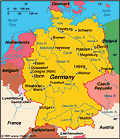Germany
| Facts & Figures |
|---|
|
|
President: Joachim Gauck (2012)
Chancellor: Angela Merkel (2005)
Land area: 135,236 sq mi (350,261 sq km); total
area: 137,846 sq mi (357,021 sq km)
Population (2014 est.): 80,996,685 (growth
rate: –0.18%); birth rate: 8.42/1000; infant mortality rate: 3.46/1000;
life expectancy: 80.44
Other large cities: Hamburg, 1.796 million;
Munich, 1.364; Cologne, 1.006 million
Monetary unit: Euro (formerly Deutsche
mark)
|
Geography
Located in central Europe, Germany is made up of
the North German Plain, the Central German Uplands (Mittelgebirge), and
the Southern German Highlands. The Bavarian plateau in the southwest
averages 1,600 ft (488 m) above sea level, but it reaches 9,721 ft (2,962
m) in the Zugspitze Mountains, the highest point in the country. Germany's
major rivers are the Danube, the Elbe, the Oder, the Weser, and the Rhine.
Germany is about the size of Montana.
Government
Federal republic.
History
The Celts are believed to have been the first
inhabitants of Germany. They were followed by German tribes at the end of
the 2nd century
B.C.
German invasions destroyed
the declining Roman Empire in the 4th and 5th centuries
A.D.
One of the tribes, the Franks, attained
supremacy in western Europe under Charlemagne, who was crowned Holy Roman
Emperor in 800. By the Treaty of Verdun (843), Charlemagne's lands east of
the Rhine were ceded to the German Prince Louis. Additional territory
acquired by the Treaty of Mersen (870) gave Germany approximately the area
it maintained throughout the Middle Ages. For several centuries after Otto
the Great was crowned king in 936, German rulers were also usually heads
of the Holy Roman Empire.
By the 14th century, the Holy Roman Empire was
little more than a loose federation of the German princes who elected the
Holy Roman Emperor. In 1438, Albert of Hapsburg became emperor, and for
the next several centuries the Hapsburg line ruled the Holy Roman Empire
until its decline in 1806. Relations between state and church were changed
by the Reformation, which began with Martin Luther's 95 theses, and came
to a head in 1547, when Charles V scattered the forces of the Protestant
League at Mühlberg. The Counter-Reformation followed. A dispute over the
succession to the Bohemian throne brought on the Thirty Years' War
(1618–1648), which devastated Germany and left the empire divided into
hundreds of small principalities virtually independent of the emperor.
|
|


Tidak ada komentar:
Posting Komentar